
Lunar Landing Training Vehicle NASA 952
Text copyright 2005 by Eric M. Jones. All rights reserved.
All photographs of the LLTV 952 display were taken by John Osborn in August 2004. Used with permission.
John writes, "These pictures were taken with the able technical assistance of Brion Au. The poor focus on many pictures is a result of the unusual techniques required to take them and could not be helped."
Last revised 29 April 2006.
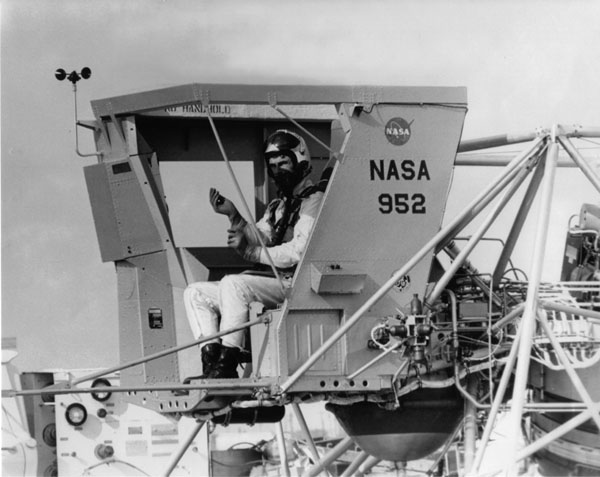
Gene Cernan in the cabin of the only LLTV (NASA 952)
that survived to the end of the Apollo Program.
(Click on the image for a larger version.)
The Lunar Landing Training Vehicle (LLTV) - sometimes called The Flying Bedstead - was an open framework vehicle which, according to Journal contributor Ed Hengeveld, was equipped with a "turbofan engine which could be throttled to support five-sixths of the weight of the vehicle. Lift for the remaining one-sixth of the LLTV's weight was provided by two hydrogen peroxide lift rockets. These engines were operated by the pilot to simulate the engine that the Lunar Module would use during its descent to the Moon." The LLTV was also equipped with a set of maneuvering thrusters similar to those on the LM so that the pilot could get a seat-of-the-pants feel for flying the LM.
NASA built two copies of an earlier model called the Lunar Landing Research Vehicle (LLRV) and three LLTVs. Three of these five were lost in accidents: one on 6 May 1968 with Neil Armstrong as pilot; one on 8 December 1968 with Joe S. Algranti as pilot; and one on 29 January 1971 with Stuart M. Present as pilot. All three pilots bailed out safely.
After the third accident, only one of the LLTVs remained: NASA 952.
Apollo 12 Commander Pete Conrad commented, "(NASA Administrator) Dr. Gilruth, bless his soul, just worried to death that somebody was going to get bagged in an LLTV. And so, he asked everybody when they came back (from the Moon) 'Do you think it's necessary to fly the LLTV?' And, the feeling that I think Neil had and myself - and I'm quite sure the rest of the guys - was 'Yes, you really should go ahead and fly the LLTV.' But, having had the three accidents and having that one vehicle left, Dr. Gilruth asked the guys to figure out how many flights we got on a vehicle before we crumped one. And it turned out to be like 260 flights or something like that. To finish the training after the third accident, they had to fly 240 more flights; and, so, when Gene (Cernan, the Apollo 17 Commander) flew the last flight in his training, the thing went to the Smithsonian or whatever because nobody was ever going to fly that thing again as far as Gilruth was concerned. And he almost didn't authorize the training, see. And so, at least the early guys pushed very hard for everybody to continue flying it."
As of August 2004, the surviving LLTV was on display in the lobby of Building 2 at NASA's Johnson Space Center. Journal Contributor John Osborn, who took all of the photographs linked below, writes, "The LLTV is suspended from the ceiling, making close-up photography a challenge."
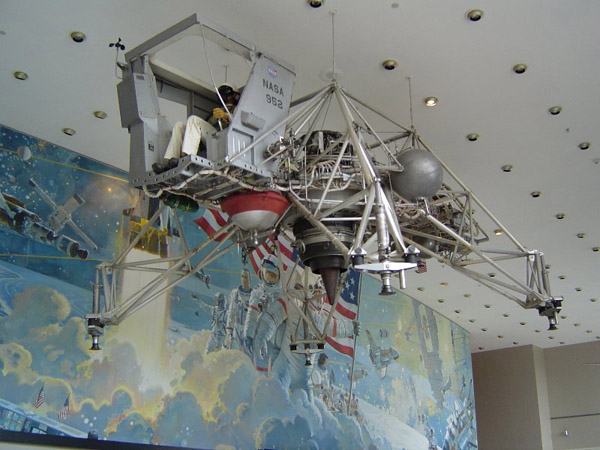
Left-side view of LLTV NASA 952
on display in the lobby of Building 2 at the NASA Johnson Space Center.
(Click on the image for a larger view.)
JSC Historical Display
- Astronaut Praise for the LLTV ( 97k ).
- Manned Spacecraft Center Roundup ( 102k ), March 31, 1967.
- Manned Spacecraft Center Roundup (Drawing) ( 100k )
- Manned Spacecraft Center Roundup (Text) ( 273k )
- LLTV NASA 952 at Ellington AFB ( 100k ).
- Alan Shepard posing with LLTV NASA 952 ( 96k )
NASA Photo S70-56287, December 14, 1970.
- LLTV NASA 952 Flying at Ellington AFB ( 98k )
- LLTV NASA 952 Plan Schematic ( 158k )
- 8 December 1968 Accident ( 100k )
- 8 December 1968 LLTV in Flight Prior to the Accident (close-up) ( 98k )
- 8 December 1968 Accident Text ( 187k )
- 8 December 1968 Accident (close-up) ( 100k )
Exterior of LLTV NASA 952
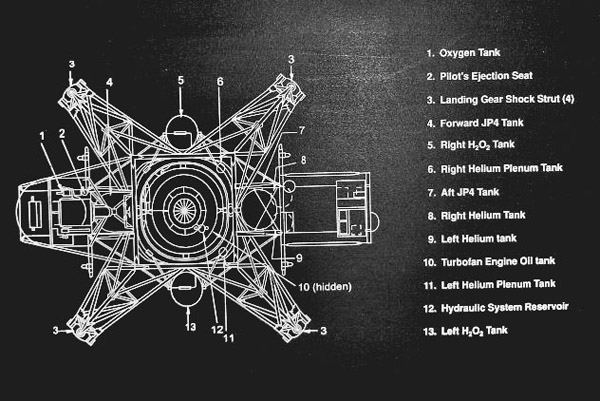
Plan Schematic
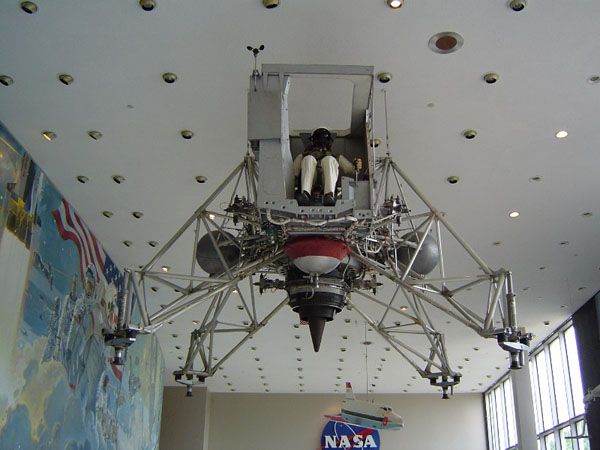
Front view of LLTV NASA 952 from below.
(Click on the image for a larger view.)
- Front view ( 102k )
- Back view ( 101k )
- Left Front view ( 101k )
- Righthand Front view ( 101k )
- Righthand side of the cabin ( 99k ) showing Apollo 13-17 patches and an RCS cluster at bottom left.
- Lefthand side of the cabin ( 95k )
- Lefthand side thrusters ( 96k ) with part of the left-front landing gear support in the right foreground.
- Wire bundles under the Cabin ( 101k )
- General Electric CF-700-2V turbofan jet engine ( 98k ) used to support five-sixths of the LLTV's weight. Note that the engine is gimballed. Note the green oxygen bottle under the righthand side of the cabin. The red-collared Forward JP4 Tank is just forwward of the GE engine. The Aft JP4 Tank is to the right of the engine. One of the two, grey, spherical hydrogen peroxide tanks is at the center top in this image and the other tank is on the opposite side of the engine.
- View of the underside looking aft ( 100k ) showing the engine, the red-collared aft JP4 tank, the lefthand side landing gear, and the grey, spherical hydrogen peroxide tanks on either side of the engine.
- Underside on the righthand side of the engine ( 95k ) showing some of the gimbal structure. Also showing the underside of the RHS hydrogen peroxide tank and associated piping.
- Green Oxygen Bottle ( 101k )
- Underside just aft of the engine ( 99k ) showing the red-collared Aft JP4 Tank and two smaller, grey, spherical helium tanks. A boom just aft of the JP4 Tank supports two sets of thrusters. The right rear landing gear on the right.
- Underside just aft of the engine ( 94k ) Alternate view forward.
- Lefthand Aft Landing Gear ( 97k )
- Lefthand Aft Thrusters ( 100k )
- Tail Structure ( 98k ) Structure aft of the two spherical helium bottles.
Cockpit of LLTV NASA 952
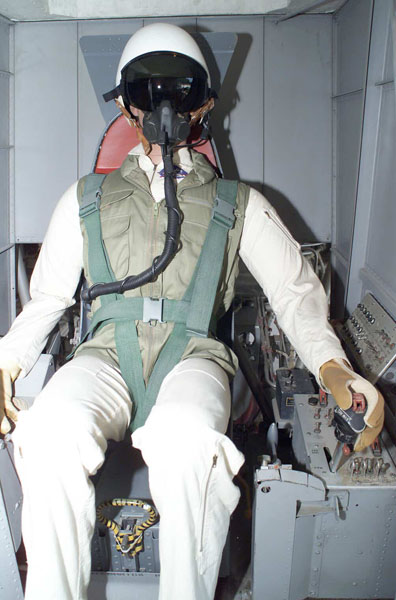
View into the cabin from the front, showing a
seated manikin/dummy with its left hand on a controller
Panels of switches and circuit breakers are on the pilot's left.
Similar layout and functions to the panels
to the Commander's left in the LM.
(Click on the image for a larger version.)
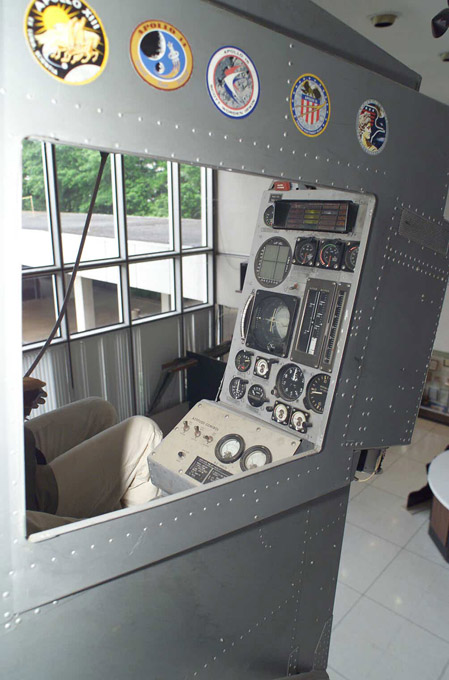
View into the cabin through the righthand window.
The instrument panel has a similar layout
and location as the one in the LM.
The 'eight ball' is prominent at left center
with the crosspointers immediately above it.
(Click on the image for a larger version.)
- Rotational Hand Controller ( 87k ) John Osborn writes "This rotational hand controller was recovered from the 8 December 1968 crash of LLTV No. 1. The pilot used it in his right hand to pitch, roll, or yaw the vehicle."
- View from the Front ( 154k ) Note the switch/circuit-breaker box sticking through the wall on manikin's left. This panel corresponds to the panels on the Commander's left in the LM. A set of thrusters can be seen just aft of the cabin and, farther back, one of the grey, spherical JP4 tanks.
- View from the Front ( 148k ) showing additional detail of the lefthand panel. Note the tiger-striped ejection handle on the front of the seat.
- View from the Front ( 148k ) showing additional detail of the lefthand panel. Note the tiger-striped ejection handle on the front of the seat.
- Lefthand Panel from the Right ( 134k ) showing additional detail of the lefthand panel. The left-front landing gear can be seen at the lower right.
- Switch/Circuit-Breaker Panel from the Front ( 148k ) showing detail from a higher vantage point.
- Righthand Panel from the Left ( 133k )
- Righthand Panel Thru the Righthand Window ( 152k ) An 'eight-ball' (or Flight Director Attitude Indicator) dominates the lefthand side of the panel, with the crosspointer immediately above it. Note the mission patches above the window.
- Righthand Panel - Closer View ( 167k )
- Righthand Panel - Closer View ( 137k ) showing more detail of the left side.
- View across the cabin thru the Righthand Window ( 150k ) The Attitude Control section of the right-hand panel is at the bottom.
- Righthand Panel - Attitude Control Section ( 155k )
Journal Home Page






